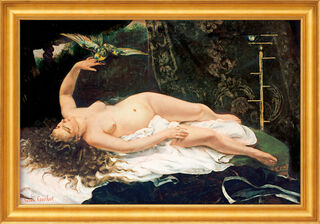Gustave Courbet
1819-1877
The French painter fled to Switzerland in 1873, where he died on 31 December 1877. As a supporter of the revolutionary government in the Franco-Prussian War of 1870/71 and a member of the Commune, he was blamed for the wreckage of the Vendôme Column, which was the symbol of the hated and defeated Empire. After completing his six-month prison sentence, he evaded the costs of its re-building by fleeing to Switzerland.
Born on 10 June 1819, in Ornans near Besançon, Courbet began his education by studying law but soon found greater interest in painting. He also gave up this apprenticeship but continued studying as an autodidact. He soon found his characteristic style: attention to detail, plasticity and high expressiveness. In addition, a characteristic was realism, which visualises his anti-authoritarian-social attitude. In his writings, he declared: "Painting is an essentially concrete art and can only consist of the representation of real and existing things. (...) Realism is, by its very nature, a democratic art."
During his lifetime, Courbet was not recognised in France but was appreciated greatly in Germany. His works had a great influence on painters such as Wilhelm Leibl and Hans Thoma. His landscape and figure paintings are not simply realistic depictions of nature but often have a parable-like quality.

